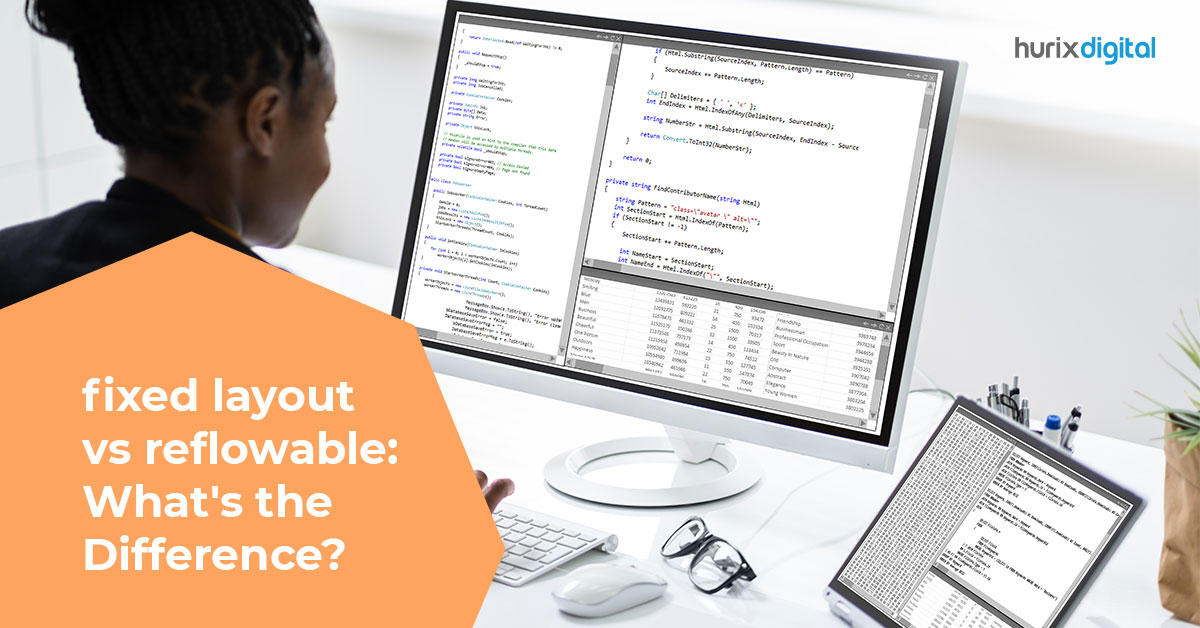
epub Fixed layout Vs. Reflowable: What’s the Difference?
In the world of eBooks, there are two main formats that every author, publisher, and reader should be aware of: ePub fixed layout vs reflowable. Both of these eBook formats have their own strengths and weaknesses and are suited for different types of eBooks. However, choosing the right option can be tricky, especially for new publishers and writers.
As we move further into the digital age, eBooks have become increasingly popular. eBook sales are projected to reach $14.38 billion in 2023, making up 36% of total book sales.
This makes it a sizeable market, and the increasing popularity with the push from businesses towards more digital mediums means publishers and writers should consider making their print copies available in digital formats for their customers.
This blog post will dive deeper into the differences between these two eBook formats, their advantages and disadvantages, and which format you should choose for your next eBook project.”
Table of Contents:
- What are Fixed Layout eBooks?
- What are Reflowable eBooks?
- Differences between Fixed Layout and Reflowable eBooks
- In Summary: Which One to Choose?
What are Fixed-Layout eBooks?
Fixed layout eBooks are digital books designed to preserve the same layout as their print counterparts, with images, text, and other elements arranged in a fixed position on the page.
In other words, the layout of each page is predetermined and fixed, so readers can’t adjust the font size, line spacing, or margins.
These eBooks are ideal for books with complex layouts, such as children’s books, graphic novels, cookbooks, travel guides, and technical manuals, as they allow for precise placement of text, images, and other visual elements.
Fixed layout eBooks have several benefits and can be created in several formats, including EPUB, PDF, and Amazon’s KF8 format.
However, it’s important to note that fixed-layout eBooks may not be compatible with all devices and platforms. They require a specific layout and may not adapt well to different screen sizes or resolutions. So, it is recommended to understand the benefits of fixed layout vs. fluid to make the correct choice.
What are Reflowable eBooks?
Reflowable eBooks are designed to adapt to the screen size and font size selected by the user. This means that the text, images, and other elements will reflow based on the screen size, making them a good choice for novels, non-fiction books, and other text-heavy books.
In addition, reflowable eBooks are typically created in EPUB or MOBI format, and they can be read on a wide range of devices that support these formats.
Reflowable eBooks are the most common type of eBooks widely used in the digital publishing industry. They are created using HTML and CSS codes, which makes them flexible and adaptable. They can be read on any device, from smartphones to tablets and e-readers.
Reflowable eBooks allow the reader to change the font size, line spacing, and margin width according to their preferences, making the reading experience more comfortable and personalized. Thus, they are ideal for text-heavy books like novels, biographies, and non-fiction.
Checkout our Exclusive eBook: The Paradigm Shift in Higher Education with Curriculum Development
Differences between Fixed Layout and Reflowable eBooks
Now that we know what fixed layout and reflowable eBooks are, here is a look at the key differences between the two:
1. Layout
The most obvious difference between ePub fixed layout vs reflowable eBooks is the layout. Fixed layout eBooks have a predetermined layout, meaning that the layout of each page cannot be changed by the reader.
On the other hand, reflowable eBooks have a flexible layout that adapts to the screen size and orientation of the device being used to read the eBook.
2. Designed for a Particular Category
Fixed layout eBooks are typically designed for books that have a lot of images or complex layouts, such as children’s books, cookbooks, or graphic novels.
Reflowable eBooks are designed for books with a simpler layout, such as novels, non-fiction, or poetry.
3. Font Size
With fixed-layout eBooks, the font size is set and cannot be changed by the reader. However, in reflowable eBooks, the reader can easily adjust the font size to fit their preferences.
4. Compatibility
Fixed layout eBooks are not compatible with all devices and eReaders. They are typically designed for specific devices, such as the iPad or Kindle Fire.
Reflowable eBooks are compatible with a wider range of devices and eReaders, including smartphones, tablets, and eReaders.
5. File Size
Fixed layout eBooks tend to have a larger file size than reflowable eBooks. This is because fixed-layout eBooks contain images and other elements not present in reflowable eBooks.
In Summary: Which One to Choose?
Still not sure about which option to choose, reflowable or fixed layout?
To conclude the blog, the choice between a epub fixed layout vs reflowable depends on the specific needs and preferences of the reader and the publisher.
Fixed layout eBooks are best for content that requires precise layout and design, such as children’s books, cookbooks, and graphic novels. On the other hand, reflowable eBooks are more versatile and accessible, with the ability to adjust to different screen sizes and font sizes.
Whether you’re a reader or a publisher, choosing the suitable eBook format can make all the difference in creating a successful and enjoyable reading experience.
So, make sure you pick the right option, and if you need professional guidance, consider an eBook transformation partner like Hurix Digital to help you take the right steps and reach your readers effectively.
Further, read about the 5 Factors to Consider While Choosing the eBook Conversion Service Provider and get started with your digital publishing journey!

Vice President – Content Transformation at HurixDigital, based in Chennai. With nearly 20 years in digital content, he leads large-scale transformation and accessibility initiatives. A frequent presenter (e.g., London Book Fair 2025), Gokulnath drives AI-powered publishing solutions and inclusive content strategies for global clients




